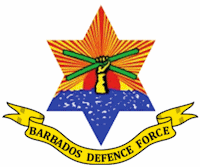Barbados Defense Force (BDF) - Coast Guard
 The maritime responsibilities of the Coast Guard included interdiction of vessels engaged in smuggling and drug trafficking, search and rescue, immigration control, and protection of fishing grounds in cooperation with other regional states under the terms of the 1982 Organisation of Eastern Caribbean States (OECS) Memorandum of Understanding.
The maritime responsibilities of the Coast Guard included interdiction of vessels engaged in smuggling and drug trafficking, search and rescue, immigration control, and protection of fishing grounds in cooperation with other regional states under the terms of the 1982 Organisation of Eastern Caribbean States (OECS) Memorandum of Understanding.
The Dutch company Damen was in negotiations with Barbados to sell three medium-endurance 110-foot patrol craft. Damen was offering an excellent deal with financing and a repair facility. Barbados had also recently been investing heavily in its own defense infrastructure, in the form of a new Coast Guard base (at a cost of $29.5 million USD) and a new pension plan. It is likely that these new projects were funded with the money donated by China, and are also aimed at building capacity with off-shore oil exploration in mind.
In 2009 newly-appointed Barbados Coast Guard Commander Sean Reece confirmed that he had been brought in to weed out internal corruption within the Coast Guard, which he has sought to address effectively and swiftly. In his effort to identify and isolate potentially corrupt officers and seamen, he had decided to require all officers to pass a polygraph examination. According to Reece, roughly twenty-five percent of the Barbados Defense Force (BDF) had been polygraphed by November 2009, starting with those who held critically sensitive positions. As a result, some officers had already been moved to non-sensitive slots because of their polygraph results.
Barbados, which had invested heavily in blue water vessels, was willing to do more to patrol within the region, but faces its own operational limits from the cost of fuel and crew salaries and benefits to undertake missions in international waters.
The Barbados Coast Guard accepted delivery of its third Damen Stan 4207 patrol vessel, the flagship HMBS TRIDENT, in 2008 at their new Headquarters HMBS PELICAN. The delivery was the final part of US$37 million package that included two other vessels of similar class, three 40-meter long range fast patrol boats, two 40-footers and three 21-foot in-shore patrol craft.
The Government of Barbados had taken the bold step of acquiring the necessary resources to safeguard its own security without reliance on international agencies. NSG was engaged as a consultant and tasked with identifying the most appropriate technology to meet this goal. Having done so the remit was extended to include the procurement and financing of the equipment required for the land forces. This first phase was undertaken in 1999/2000 and was completed on time and to budget. In the second phase, NSG worked closely with the Barbados Coast Guard to identify the most appropriate technology that would restore its capabilities. As an island Barbados must have the resources to provide that critical first line of security and capability along its coastline.
Having established precisely what resources were necessary NSG undertook research to identify the shipyard that could deliver the proven technology that would meet the full scope of supply. The DAMEN Shipyard Group was selected having demonstrated its capabilities with orders secured from the UK Customs and Excise and more closer to home from the Jamaica Defence Force. A key factor in the final decision was after sales support. Assets that will be in service for more than 20 years require the long term maintenance and the resources a company with the necessary reputation for build quality and engineering capability. DAMEN has a proven track record in this regard.
The contract was placed in late December 2006 and within 7 months the first vessel was delivered. In a two year programme the Coast Guard took delivery of three Damen Stan 4207 patrol vessels, the HMBS LEONARD C. BANFIELD, HMBS RUDYARD LEWIS and HMBS TRIDENT. Named after the Barbados Defence Force's (BDF) first Chief-of-Staff Colonel Leonard Banfield, the first vessel arrived at the new Coast Guard's headquarters on Spring Garden, St. Michael, HMBS PELICAN.
At the time the Base Commander Ricky Shurland stated. "This vessel is a significant addition to the Coast Guard's flotilla and it is expected that it will significantly assist in the safety and security of the waters around Barbados". HMBS LEONARD C. BANFIELD and HMBS PELICAN were commissioned in a ceremony on September 14, 2007.
The Barbados Coast Guard took up residence in its new base on Spring Garden in 2006, a project that cost the government $59.5m. Minister of State in the Prime Ministerís Office, Reverend Joseph Atherley revealed this, while speaking at the St Annís Fort during the 27th Anniversary parade of the Barbados Defence Force (BDF) 23 August 2006. Saying that the base will be outfitted with the most cutting edge equipment, the Minister noted that this base must serve as a hub in the Southern Caribbean. Additionally the new base would allow the berthing of larger naval and Coast Guard vessel from regional and international partners.
The Barbados Coast Guard increased its forces and conducted more training in an effort to counter narcotic-drug trafficking. Part of that training involved Carr Sailors training the Barbados Coast Guard on U.S. Navy visit, board, search and seizure (VBSS) tactics. Sailors from USS Carr (FFG 52) completed theater security cooperation events and training to improve interoperability with the Barbados Coast Guard during a four day visit to Barbados, 4-7 May 2008. During the visit Carr Sailors gave tours to 50 Barbados Sea Cadets and 20 Barbados Coast Guardsmen. The Sea Cadets were able to operate the ship's fire hoses off the flight deck and observe life aboard a ship. As Barbados looks to expand its Coast Guard, it relies on its Sea Cadets for the future leadership.
|
NEWSLETTER
|
| Join the GlobalSecurity.org mailing list |
|
|
|

